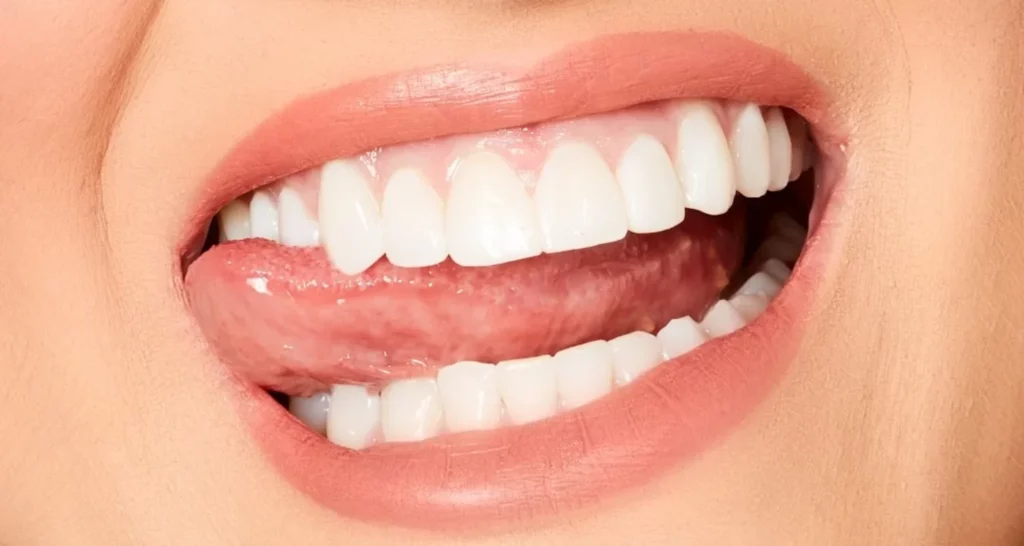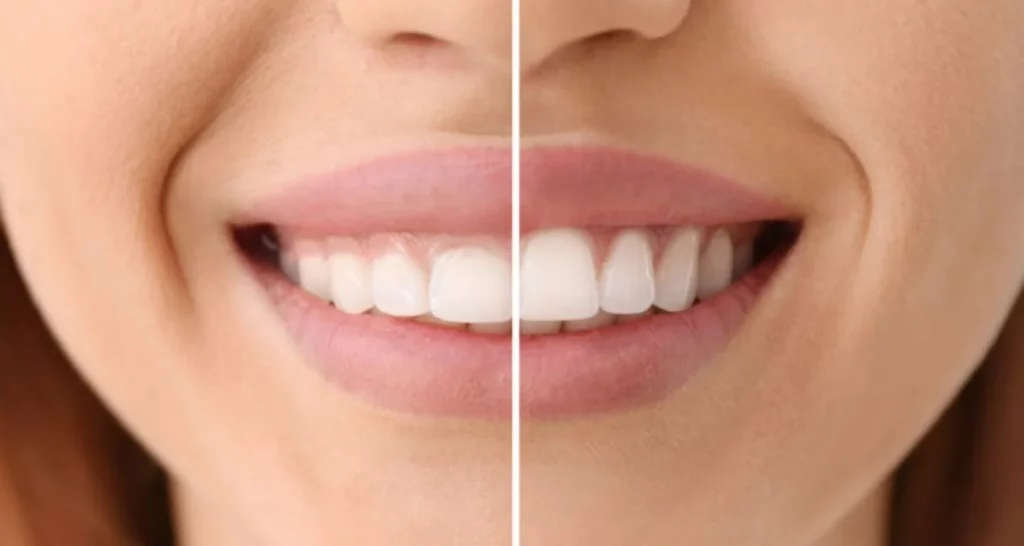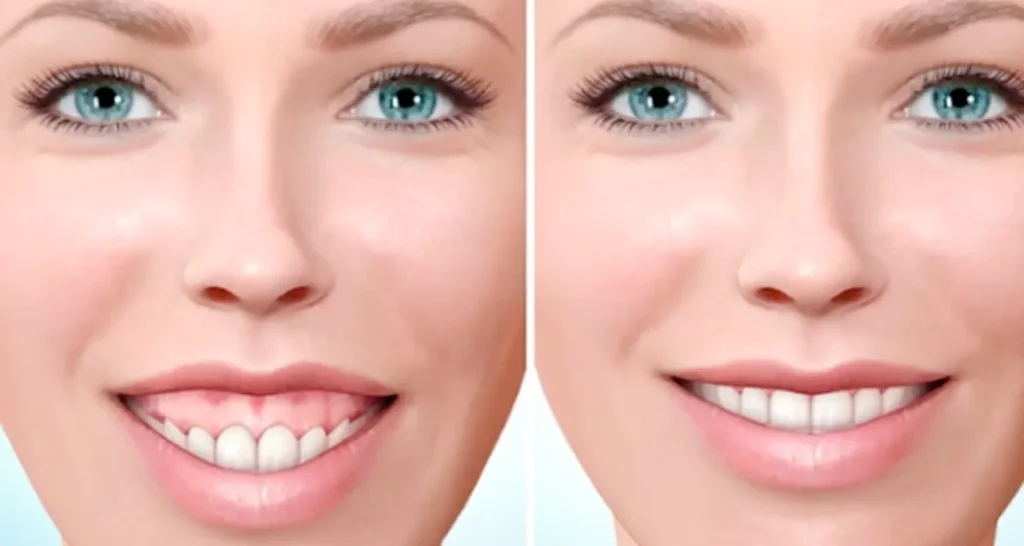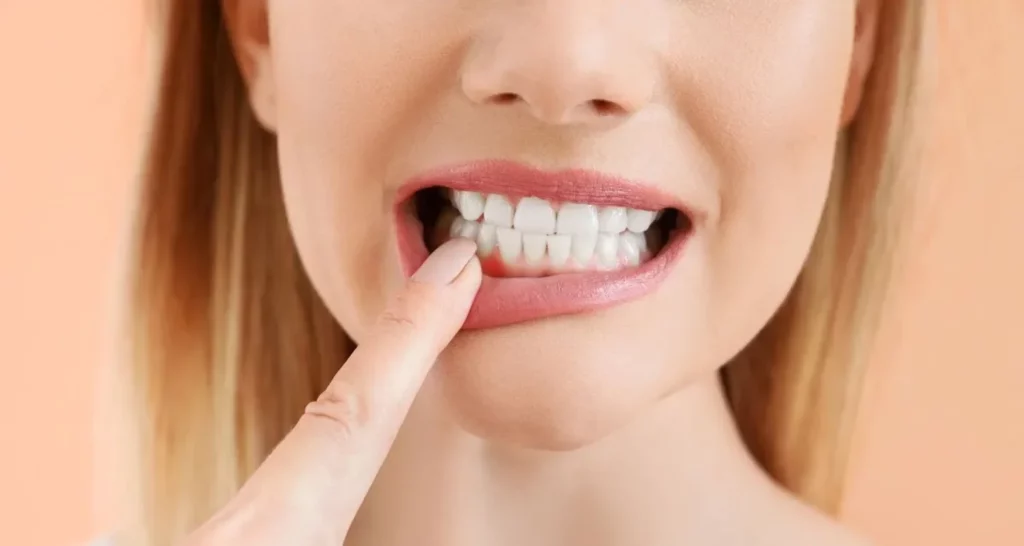Last Updated on: 13th December 2025, 06:32 am
Gum contouring is a cosmetic dentistry procedure aimed at creating custom, aesthetically pleasing gum lines for every smile. Gum heights can vary significantly from person to person, with some individuals exhibiting high, low, or irregular gum lines. However, it’s crucial to understand the potential gum contouring risks before undergoing this treatment to make informed decisions.
A beautiful smile encompasses more than just white, straight teeth. Healthy and uniform gums are equally important. Cosmetic dentistry extends beyond teeth whitening and straightening, focusing on achieving a harmonious balance between gums, teeth, and lips. While numerous options exist to attain the desired smile, it’s essential to be aware of the potential risks associated with these procedures.
This article serves as a comprehensive guide to gum contouring. Whether considering the treatment or simply curious about gum contouring risks, this post provides essential information.
What is gum contouring?
Gum contouring, also known as gingival sculpting or gum reshaping or gingivoplasty, is a transformative procedure that can help you achieve the perfect gum line. The procedure involves trimming excess tissue or restoring receded gums to enhance your smile, eventually boosting your overall self-confidence. Often an elective cosmetic procedure, it improves the appearance of your gums and teeth. Additionally, it is used to treat periodontal disease when other treatments have not been successful.
Indications for gum contouring
Gum contouring may be an effective solution for your dental problems if you have:
● Gingivitis or periodontitis
● A “gummy smile”
● Periodontal pockets where gums have receded from teeth
● Swollen and puffy gums from braces or orthodontic appliances (usually preventable with better brushing and flossing).
● Tooth malposition that causes excess gum tissue
Certain medications, such as amlodipine for high blood pressure or cyclosporine as an immunosuppressant, can generate excess gum tissue that would eventually require removal or contouring.
Note: If you develop swollen, overgrown gums after starting a particular medication, be sure to inform your healthcare provider. They may be able to switch medications or change your dosage.
Potential Gum Contouring Risk Factors
As with any surgical procedure, gum contouring comes with its share of risks that include:
● Infection: The risk of infection is relatively low, but proper post-operative care can further minimize this risk.
● Relapse of gum tissue.
● Allergic reaction to the local anesthetic used.
● Swelling and discomfort: The treated area may be swollen and sore for several days and might cause mild discomfort.
● Bleeding: Some bleeding is normal, especially within the first 24 hours post- operatively.
● Uneven gums: This procedure is highly operator-sensitive. If not performed carefully, it can result in an asymmetric gumline.
● Teeth sensitivity: Removing unnecessary gum tissue can expose areas of the tooth, such as the root, to the oral environment, leading to sensitivity.
What are the benefits of gum contouring?
Gum contouring provides several benefits, including:
● Removing excessive or overgrown gum tissue
● Correcting a “gummy smile” that makes your teeth look short
● Reducing harmful oral bacteria
● Eliminating periodontal pockets around teeth
● Making brushing and flossing more effective by improving access to problem areas
● Promoting healthier teeth and gums
The suitable candidate for gum contouring
Gum contouring is appropriate for individuals with receding or excessive gums, but is best suited for those with healthy teeth and gums who maintain good oral hygiene. However, those with poor oral hygiene, complex dental issues, medical complications such as diabetes (which can delay wound healing), or cardiac pacemakers, should consult their dentist to determine if the procedure is suitable for them.
What does gum contouring involve?
Gum contouring is typically performed by a periodontist or cosmetic dentist in an office setting, usually in a single visit. Patients are usually awake during the procedure, with local anesthesia administered to numb the gum area.
The doctor will use a soft tissue laser or scalpel to remove excess gum tissue and reshape the gum line, exposing more of the tooth and sutures may be used to secure the gum tissue in place.
If you have receding gums, the procedure may involve adding tissue in the area of recession to ameliorate the lost tissue. The doctor will take tissue from another part of your mouth, like your palate, and attach it around your teeth to extend and reshape your gum line.
The procedure typically lasts for about 1 to 2 hours, depending upon the extent of the contouring and resculpting needed.
How long would it take for the gums to heal?
Recovery from gum contouring typically takes about a week or less for most individuals. The timeline will vary based on factors such as the number of teeth treated, your body’s healing ability, and your oral hygiene practice. Your oral healthcare provider will advise you on what to anticipate in your specific case.
Additional treatments may be necessary to achieve the desired results; your dentist will assess your progress after approximately 8 to 12 weeks to determine if any further procedures are needed.
Recovery post gum contouring: Do’s and don’ts
After gingival sculpting, your dentist will give you a list of detailed post-operative instructions. It is of utmost importance to follow these guidelines closely.
Some basic recommendations for gum contouring aftercare:
● Keep the surgical site clean by gently brushing and using an antibacterial mouthwash, avoiding vigorous brushing. Maintain regular brushing and flossing for other teeth.
● Follow your prescribed medications exactly as directed, including antibiotics and pain relievers. Over-the-counter options like acetaminophen (Tylenol) or ibuprofen (Advil) can also be used.
● Use an ice pack on your outer jaw to reduce swelling and inflammation.
● Stick to soft foods such as yogurt, mashed potatoes, cooked vegetables, and scrambled eggs for at least a week. Avoid hard or crunchy foods.
● Refrain from touching the surgical area with your fingers or tongue to aid in healing.
● Avoid alcohol and tobacco use during the recovery period.
● Adhering to these instructions will help ensure a quick recovery and avoid any gum contouring risks.
Gum contouring can significantly improve your smile and overall oral health. While it is a relatively simple minor surgical procedure, a few risks are involved. However, these can be easily prevented by carefully following your dentist’s instructions.
Consult your nearest periodontist or cosmetic dentist to get their opinion on gum contouring and determine if you are a suitable candidate for the procedure.
Frequently Asked Questions
What are the risks of gum reduction surgery?
Gum reduction surgery, also known as gingivectomy or gum contouring, carries certain risks that include:
- Infection: If the surgical site isn’t kept clean, there’s a risk of infection. This is typically managed with antibiotics and proper post-operative care.
- Excessive bleeding: Bleeding can occur during or after the procedure, which can usually be controlled by the dental surgeon.
- Gum recession: Removing too much gum tissue can expose the roots of the teeth, leading to sensitivity and a higher risk of decay.
- Pain and swelling: These are common side effects, often managed with pain relievers and anti-inflammatory medications.
Do gums grow back after ?
Gums do not grow back after gum contouring in the same way as other tissues might regenerate. The procedure aims to create a more aesthetically pleasing gum line with generally permanent results. While the gum tissue does not regenerate, maintaining good oral hygiene and regular dental check-ups can keep the remaining gum tissue healthy and prevent further issues.
How much does gum contouring cost per a single tooth?
The cost of gum contouring varies widely. On average, it ranges from $50 to $350 per tooth. Factors influencing the cost include the complexity of the procedure, the dentist’s experience, and the location of the practice. Dental insurance may cover part of the cost if it’s deemed medically necessary; many dental practices offer payment plans or financing options.
What is gum contouring for?
Gum contouring, or gingivoplasty, is primarily a cosmetic procedure used to improve the appearance of the gum line, often correcting a “gummy smile.” It also has functional benefits, such as improving oral hygiene by making it easier to clean around the teeth and gums. Additionally, it can be part of a treatment plan for periodontal disease, gum recession, or preparation for restorative procedures like dental crowns or veneers.
Is gingivectomy a high-risk procedure?
Gingivectomy, the surgical removal of gum tissue, is generally considered low-risk when performed by an experienced dental professional. Common risks include:
- Infection: Managed with antibiotics and proper care.
- Bleeding: Usually controlled by the dentist.
- Swelling: Managed with pain relievers and anti-inflammatory medications.
Patients with conditions like uncontrolled diabetes or immune disorders face higher risks and should discuss their medical history with their dentist. Despite these risks, gingivectomy is a routine procedure with a high success rate.
Share
References
1. Munshi, Maha. (2023). A Systematic Review: Methods of Gingivectomy for Esthetic Marginal Periodontal Tissue Conditioning. American Journal of Chemistry and Pharmacy. 2. 74-85. 10.54536/ajcp.v2i2.1681.
2. Kumar, P., Rattan, V., & Rai, S. (2015). Comparative evaluation of healing after gingivectomy with electrocautery and laser. Journal of oral biology and craniofacial research, 5(2), 69–74. https://doi.org/10.1016/j.jobcr.2015.04.005
3. Marks, H., Brennan, R. (Sep, 2023). Gum Contouring. WebMD. https://www.webmd.com/oral-health/gum-contouring-procedure
4. Higuera, V., Archibald, J. (Feb, 2020). What Is Gum Contouring and Why Is It Done?. Healthline. https://www.healthline.com/health/gum-contouring
5. Burch, K., Luong, B. (Aug, 2022). Everything You Need to Know About Gum Contouring. Verywellhealth. https://www.verywellhealth.com/gum-contouring-5323782
-
Nayibe Cubillos M. [Author]
Pharmaceutical Chemestry |Pharmaceutical Process Management | Pharmaceutical Care | Pharmaceutical Services Audit | Pharmaceutical Services Process Consulting | Content Project Manager | SEO Knowledge | Content Writer | Leadership | Scrum Master
View all posts
A healthcare writer with a solid background in pharmaceutical chemistry and a thorough understanding of Colombian regulatory processes and comprehensive sector management, she has significant experience coordinating and leading multidisciplina...



















